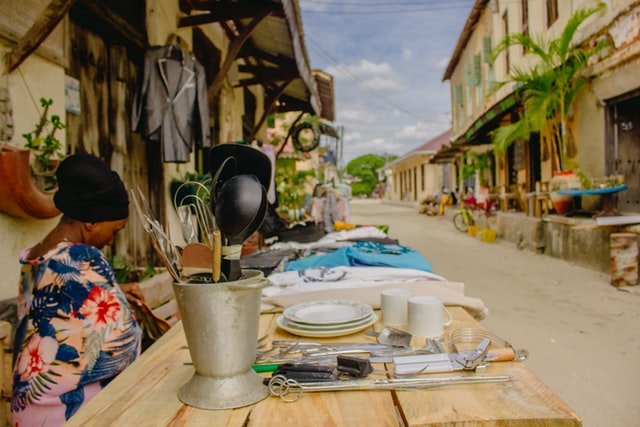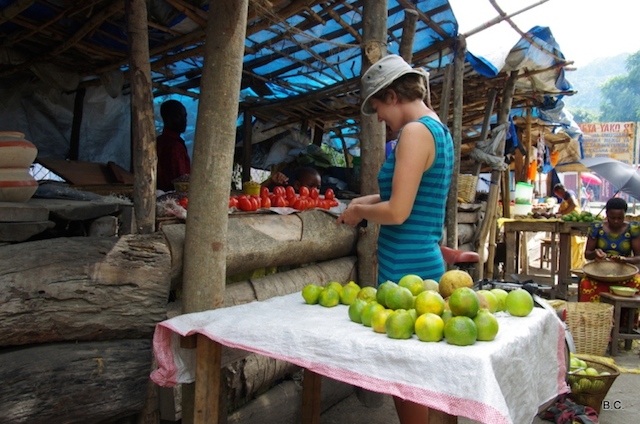Vegetarian Meals: What to Eat in Tanzania


If I had been new to Africa, this offering might have confused me. But my time on this continent had given me some insight on the issue: The idea of not eating meat by choice is simply unheard of. Here, meat signifies wealth, celebration, and bounteousness. Vegetarianism is unheard of, laughable, blasphemous, even. Only poverty inhibits people from chewing meat off bones in Africa. Yet here I was, a vegetarian in Africa. A vegetarian travel foodie, you could say.
Food, besides being a deliciously integral part of my day, is one of my favorite ways to experience a new place. By not eating meat, I felt I was missing out on a crucial aspect of African culture. Being a vegetarian in Africa is hard, but it’s not impossible. One must search harder, and meals will contain less variety—and more grease—than back home, but the hunt is undoubtedly worth it.
To celebrate my ten-year anniversary of vegetarianism—and encourage vegetarians and veggie-philes out there to delve into African cuisine—here is a one-day menu for cheap but delicious vegetarian Tanzanian food:
Vegetarian Meals: What to Eat in Tanzania
Breakfast
Dine with the locals in one of many tea houses. These informal eateries—both indoor and open-air—are packed late into the morning with people dunking all kinds of greasy bread products into their cups of chai (tea). Choose a giant chapatti, a round flatbread imported from India, or a maandazi, a chewy donut that is more greasy than sweet.
My personal favorite is a vitambua, an elliptical-shaped rice cake. Less greasy (but only by a bit!) with just the right amount of sweet, it has a spongy, moist texture inside and a crispy crust outside. If you’re in a hurry, or fancy walking with your food, you can also pick up these treats to go, along the road or in the local market.
Cost: Between $0.10 – $0.30 per bread item, another $0.30 for a cup of tea
Lunch
Though not vegan, octo-lavo vegetarians must try chipsi maayai, a specialty unique to Tanzania. It translates as “chips and eggs” and that’s exactly what it is; a chips omelet! These informal roadside stands are ubiquitous in Tanzanian towns. Look for the pile of chips behind a glass stall, with a stack of eggs on top.
While you sit at a roadside table, the cook will re-heat the chips in an oily pan and then pour the egg batter on top. Using a plate with much dexterity, he will flip and press down, flip and press down until you have a golden omelet jam-packed with chips. Served with chili sauce or fresh tomato salsa, it’s a hearty (albeit greasy) meal.
Cost: $1.25 per plate
Snack

If you’re like me, you can’t make it the entire afternoon without a little pick-me-up. So, head straight into the market and choose between an abundance of fresh fruits. If you fancy something exotic, try the creamy custard apple (tomoko), the stinky durian (finesi), or the tart baobab fruit (ubuyu). If you’re more in a salty mood, try an ear of fire-roasted maize, sold on the roadside in the afternoons and evenings.
Cost: Fruit depends on size, region and season. Maize, between $0.15-$0.30.
Dinner
An acquired taste for most foreigners, ugali is the staple food throughout most of Africa. Also called nsima or sadza (depending on the country), this maize-meal flour is pounded into a thick, porridge-like paste that sits in the stomach like a rock. It is preferably eaten with a meat stew, but can also be served with beans and chinese (“rape” in English), a spinach-like green.
You are usually served two or three balls of ugali with smaller side portions of whatever accompaniment you’ve chosen. With the right hand, pull away a bite-size portion of the ugali and roll it around in the palm of your hand until it forms a ball. Then, dip it into the accompaniments and pop it into your mouth. You can, of course, eat this meal with a fork, but it’s tastier – and more fun – to eat with your hands!
Cost: Between $2-4, depending on the cleanliness of the establishment.
A day of vegetarian eating in Tanzania certainly cannot boast the same taste, variety, or health as South or Southeast Asian food (biryani! pad thai! pho!). But what it lacks in flavor, it makes up for in cultural value.
Eating Tanzanian brings you into the tea houses and markets, forces you to learn a few words of KiSwahili, and makes you feel just a little bit more local.
It’s not too heavy on the wallet, either!
Vegetarian Meals: Vegetarian Tanzanian Food
Related Reading
What It’s Like to Be a Woman in Tanzania
Have you traveled to Tanzania? What were your impressions? Email us at editor@pinkpangea.come for information about sharing your experience and advice with the Pink Pangea community. We can’t wait to hear from you. Top photo by Unsplash.










I’m glad to be able to help! Tanzania – and Africa in general – isn’t the easiest place to be vegetarian. The veggie options I found were a bit on the greasy/unhealthy side. But with a few trips to the market in between you can get a balanced diet and have lots of fun trying new things and exploring the culture. Enjoy your trip – Tanzania is great! (It was my favorite country in East Africa, and I recently wrote about why here: http://wanderingfootsteps.blogspot.com/2014/07/ode-to-tanzania.html)
Thank you so much for this information!
I am planning a trip to Tanzania for the year of 2015, and was quite concerned with me being a vegetarian, and weather or not I could survive their eating no meat. So this has been great help for the beginning of my research.
Asante Sana!